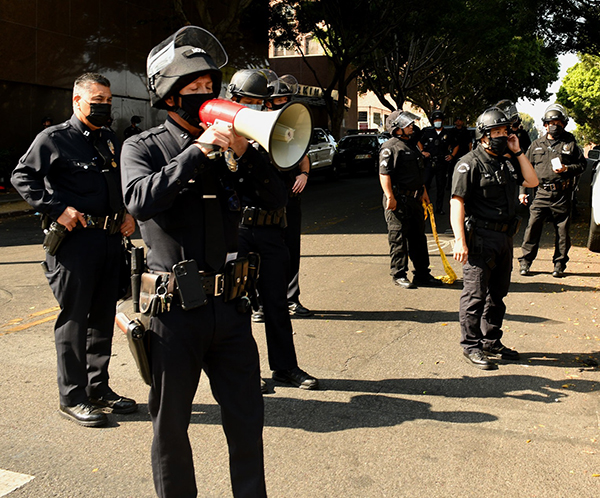By Earl Ofari Hutchinson
Contributing Columnist
Fox News, packs of conservative bloggers, the Republican Party, victims’ rights groups, police unions, district attorney organizations and much of the media have screamed for months that violent crime is at a dangerous level in America.
The impression is that Americans are at mortal risk from rape, robbery and — most terrifying — murder. Is this true. Or, rather how much of this contention is true or self-serving scare stuff?
This is the second in a two-part series examining the fact and fiction about violent crime is in America.
One argument the tough-on-crime advocates repeatedly make is that slashing spending on police services has thinned out the ranks of police departments to the point where they don’t have the personnel to work the crime beats.
None of the major cities have radically slashed or trimmed the police share of city budgets. Some major cities did garner angry headlines when they announced they were considering reducing some police budgets. However, the cuts were minimal. Overall, police budgets remain steady and, in many cities, have increased.
The number of police and police patrols remain steady. Yet, the murder rates in some of those same cities still increased. Minneapolis was a prime example.
Protesters were highly vocal after the George Floyd slaying to not only radically cut police funding but get rid of the police altogether. The latter move was soundly defeated last November.
City officials initially proposed a steep cut in the police budget. That didn’t last. They quietly restored nearly all of the funding for the police, and specifically earmarked more money to hire more police officers.
Minneapolis was one of the cities that did see a homicide spike. It had nothing to do with defunding the police since there was no defunding of the police.
Last June, the Biden administration proposed a comprehensive initiative to combat gun violence. It punched many of the right buttons — stricter gun control measures, more job and training programs for inner-city youth, more community-based violence prevention programs, support and service programs for ex-felons.
President Joe Biden was also firm on one point. That funds for the hiring of more police was imperative.
Biden went further. He pledged that his administration would ensure federal support of local law enforcement. He was emphatic.
“This is not a time to turn our backs on law enforcement or our communities,” he said. He didn’t need to worry. There was no danger that cities would allow policing and police service to markedly decline, certainly not in response to protests that would as other protest movement come and go and prove ephemeral.
One final area that is fraught with fact and fiction in the crime debate is the long-standing belief that more prisons and stiffer sentences are the only sure-fire way to reduce crime. It’s easy and popular to simply say that if you get the criminals off the street and behind bars you stop crime. On the surface, that makes sense.
The prison boom, tougher sentencing and the rash of three strikes laws in the 1980s and ’90s, seemed to correlate with the crime drop. However, studies that closely examined the issue found no direct correlation between imprisonment and crime reduction.
That was not the finding of one study on prisons and crime reduction. It was the result of more than 100 such studies.
The studies were detailed and rigorous. They came to one conclusion: prisons had no effect on reducing crime. The studies ranked non-custodial probation, fines, monitoring and diversion programs for drug and low-level offenders were far more effective in crime reduction.
Other studies found that imprisonment can increase crime and recidivism. Ex-felons are barred from voting, employment and even receiving some services. This is a prescription for forcing felons back into crime even violent crime.
California underscores this. Crime plunged in the state to a record low in 2020. However, the counties that had the highest incarceration rates had twice as many homicides as the counties that locked up fewer persons.
It also costs far more to increase incarceration than to employ other means such as diversion programs and probation to deal with offenders.
Cities did not slash police budgets, services, recruitment, hiring and weapons purchases. There is no evidence that police are hampered in their work.
They certainly are not prosecuted in any appreciable numbers for abuse and misconduct. Further, top Democrats, starting with President Biden, were among the loudest cheerleaders for funding and hiring more police and fully supporting law enforcement. The notion that somehow American streets are less safe than they were a decade ago — before Black Lives Matter and other anti-police abuse protests — is a total myth.
Still, when emotions, political agendas and media sensationalism on crime come into play, the facts mean little. Public perception and fear will always trump reality. When the public believes it is under terrible siege and nothing short of a new round of draconian tough enforcement measures can end the siege, calls for defunding the police will always stir public fury.
Earl Ofari Hutchinson is an author and political analyst. His forthcoming book is “A Young Person’s Guide to Classical Music” (Middle Passage Press). He hosts the weekly Hutchinson Report on KPFK 90.7 FM Los Angeles and the Pacifica Network.












